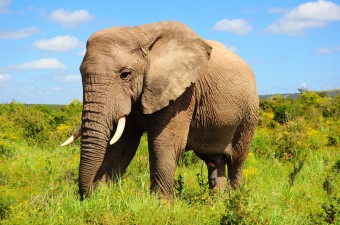The Skin of an African Elephant
 When you consider their size and how much they have to keep under wraps, African elephants have surprisingly thin skin, relatively speaking.
When you consider their size and how much they have to keep under wraps, African elephants have surprisingly thin skin, relatively speaking.
Holding Everything In
Across most of their bodies, an African elephant’s skin is only somewhere between 2 and 4 cm or .78 to 1.6 inches thick on average.
All of this relatively thin skin holds in a whole lot of elephant. Adult African elephants can weigh anywhere from just under 8,000 to just over 13,000 pounds, and all of that mass puts a tremendous amount of pressure on the animal’s skin. In fact, certain places require extra support, such as the fibroeslastic-like sheet of additional support around its belly, just to keep the elephant’s internal organs in place.[1]
Because of this tremendous pressure, it is very dangerous to perform abdominal surgery, such as a cesarean section, on an elephant. Once opened, the viscera will spill out, and it can be very difficult to stuff it all back in. In fact, rather than performing the type of cesarean commonly done on human mothers, with elephants, “an opening is made under the anus, through which the baby can be pulled out.” Even with this accommodation, elephant cesarean sections are not often successful.[2]
Keeping Cool
Elephants lack sweat glands, so they’ve developed other methods of cooling off.
Unlike most of its skin, around the ear, the elephant’s dermis can be as thin as 1 mm. This thinness allows the blood circulating in the ears’ many veins to better transfer the animal’s internal heat to the atmosphere.
Likewise, the elephant’s wrinkles help cool it as well. In addition to creating more surface area, the elephant’s wrinkles capture water when the elephant bathes, and holds it longer, providing the elephant with evaporation over a longer period of time.
Interestingly, unlike humans who have hair to keep us warm, elephant hair helps keep it cool. This is because the elephant’s sparse hair (about 1,500 per square meter), as opposed to our thick manes (about 2 million over the same area on our heads), helps transfer heat away from their body while not being thick enough to help retain it, enhancing their “ability to lose heat by up to 23%.”
The Sense of Touch
Despite its thickness, an elephant’s skin is very sensitive, to the point where it can feel a fly land on its back. Surprisingly, it is also sensitive to the sun, and baby elephants are even known to sunburn. The species’ notorious love for mud and baths helps alleviate both of these problems.
If you liked this article and the Bonus Facts below, you might also enjoy:
- Do Elephants Really Have Exceptional Memories?
- The Elephant Condemned to Death by Hanging
- 12 Interesting Facts You Probably Didn’t Know About Rhinoceroses
- How the Sun Burns Your Skin and How Sunscreen Prevents This
- Why Skin Wrinkles in Water
Bonus Elephant Facts
- Elephants can be either “right-handed” or “left-handed,” and this is often shown by greater wear on one tusk as opposed to the other. Dogs and Cats are also often right or left “handed”.
- Unlike the rhinoceros, whose horn is made of hair-like keratin, elephant tusks are actually overgrown incisors. Incredibly long, at least one-third of an elephant’s tusk is inside the animal’s head, outside of view. The outside, ivory part of the tusk is, like its other teeth, comprised of dentine surrounded by a layer of enamel. An elephant’s tusks never stop growing.
- The heaviest tusks recorded weigh about 220 pounds per tusk, while the longest ever discovered were 11 feet long! Tusks today are generally much smaller due to the ivory trade and poaching keeping them from reaching such mammoth sizes.
- In a rare example of unanimity, the whole world banned the trade in ivory in 1989 with the Convention on International Trade in Endangered Species (CITES). In the decade preceding the agreement, more than half of Africa’s elephants had been killed in order to harvest the ivory, and today, poaching continues. In fact, in 2011, only a portion of the largest seizures collected found in excess of 50 thousand pounds of poached ivory. To combat this, the U.S. Fish and Wildlife Service (FWS) had proposed regulations in February 2014 that would have placed “a near-total ban on anything made with ivory moving in and out of the U.S.” However, the sweeping regulation had many concerned that it would inhibit the transportation of “old ivory,” such as that found in antique pieces of art and musical instruments. After a public outcry, particularly from concert musicians who often need to travel with their antique, ivory-fitted instruments to perform, FWS carved out an exception in May 2014.
- Today there are somewhere between 400,000 and 600,000 African elephants remaining, and, unless things change, they are predicted to become locally extinct within 50 years.
- African bush elephant (ADW)
- African Elephant
- African Elephants (WWF)
- Africa’s first aerial elephant census to capture falling numbers
- Biology, Medicine, and Surgery of Elephants (Fowler, et al.)
- The Complete Elephant Anatomy (Animal Corner)
- Elephants
- Elephant caesarean section
- Elephant Pictures
- Elephant Tusks
- How Can Large Ears Cool an Animal?
- Musicians, Take Note: Your Instrument May Be Contraband
- Organs – Skin
- The skin of the elephants
- Stop the Ivory Trade
- U.S. allows limited exceptions to ivory ban for instruments, art
- Why do elephants have hair on their heads?
| Share the Knowledge! |
|





Is it true that the elephant has no natural predator
Also is it true that Alexander the Great met his match when his enemy charged at his army with elephants